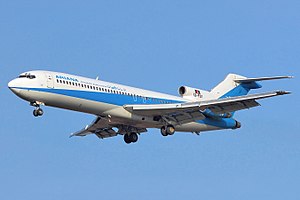Boeing 727-200F
| Boeing 727 | |
|---|---|
 |
|
| Ariana Afghan Airlines Boeing 727-200 Advanced arriving at Sheremetyevo International Airport in 2008 | |
| Role | Narrow-body jet airliner |
| National origin | United States |
| Manufacturer | Boeing Commercial Airplanes |
| First flight | February 9, 1963 |
| Introduction | February 1, 1964 with Eastern Airlines |
| Status | In limited service for cargo and private transport |
| Primary users |
Kelowna Flightcraft Air Charter Kalitta Charters Iran Aseman Airlines |
| Produced | 1962–1984 |
| Number built | 1,832 |
| Unit cost |
$4.25 million initially, $22 million by 1982
|
The Boeing 727 is a midsized, narrow-body three-engined jet aircraft built by Boeing Commercial Airplanes from the early 1960s to 1984. It can carry 149 to 189 passengers and later models can fly up to 2,700 nautical miles (5,000 km) nonstop. Intended for short and medium-length flights, the 727 can use relatively short runways at smaller airports. It has three Pratt & Whitney JT8D engines below the T-tail, one on each side of the rear fuselage with a center engine that connects through an S-duct to an inlet at the base of the fin. The 727 is Boeing's only trijet aircraft.
The 727 followed the 707, a quad-jet airliner, with which it shares its upper fuselage cross-section and cockpit design. The 727-100 first flew in February 1963 and entered service with Eastern Air Lines in February 1964; the stretched 727-200 flew in July 1967 and entered service with Northeast Airlines that December. The 727 became a mainstay of airlines' domestic route networks and was also used on short- and medium-range international routes. Passenger, freighter, and convertible versions of the 727 were built.
The 727 was heavily produced into the 1970s; the last 727 was completed in 1984. As of July 2016[update], a total of 64 Boeing 727s (4× 727-100s and 60× -200s) were in commercial service with 26 airlines, plus a few more in government and private use. Airport noise regulations have led to 727s being equipped with hush kits. Since 1964 there have been 118 fatal incidents involving the Boeing 727. Successor models include variants of the 737 and the 757-200.
The Boeing 727 design was a compromise among United Airlines, American Airlines, and Eastern Air Lines; each of the three had developed requirements for a jet airliner to serve smaller cities with shorter runways and fewer passengers. United Airlines requested a four-engine aircraft for its flights to high-altitude airports, especially its hub at Stapleton International Airport in Denver, Colorado. American Airlines, which was operating the four-engined Boeing 707 and Boeing 720, requested a twin-engined aircraft for efficiency. Eastern Airlines wanted a third engine for its overwater flights to the Caribbean, since at that time twin-engine commercial flights were limited by regulations to routes with 60-minute maximum flying time to an airport (see ETOPS). Eventually, the three airlines agreed on a trijet design for the new aircraft.
...
Wikipedia
